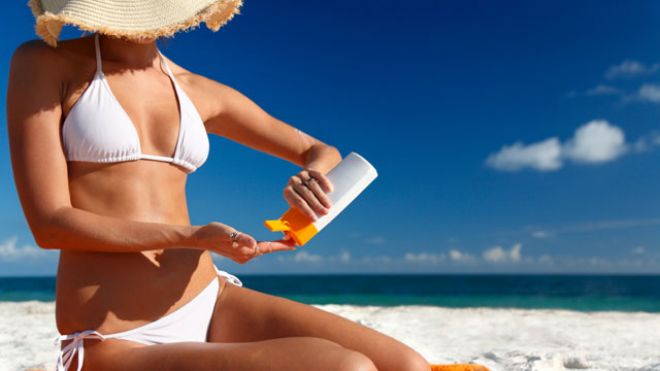
Unless you've been living under a rock, you know to apply sunscreen. There's a lifesaving reason to: About 3.5 million cases of skin cancer will be diagnosed this year. “The incidence of skin cancer, including melanoma—the deadliest kind—is going up, and wearing sunscreen is one of the best ways to prevent it,” said Dr. Ronald Moy, a dermatologist and spokesperson for the Skin Cancer Foundation. Stick with these smart tips—and check out our product picks—to make sure you're as protected as you can possibly be.
Select a sunscreen you love
Finding your sunscreen soul mate is the key motivating factor for using it regularly, experts agree. “If you think your sunscreen is pasty, thick or smelly, you have the wrong kind,” said Dr. Jeffrey Dover, clinical associate professor of dermatology at Yale University. “It may make you less likely to put it on, or to reapply when you do.” Happily, there are plenty of lightweight, sheer formulas, like Vichy Capital Soleil Foaming lotion SPF 50 ($29; vichyusa.com) and La Roche-Posay Anthelios 60 Ultra Light sunscreen fluid for face SPF 60 with Cell-Ox Shield XL ($30; laroche-posay.us).
Health.com: Which Sunscreen Is Best For You?
Remember, SPF 30 is the new 15
As a general rule, SPF 15 blocks 93 percent of UVB rays, SPF 30 blocks 97 percent and SPF 50 blocks 98 percent. Doctors now typically recommend at least SPF 30—at least being the key words. If you have a family history of skin cancer or are vacationing in a tropical spot (where the sun is especially intense), go for 50 or even 70. Just keep in mind: No sunscreen provides 100 percent protection. So to be as safe as possible, you still need to reapply every two hours and after a swim, even if you used the water-resistant kind, said Dr. Joshua Zeichner, director of cosmetic and clinical research in dermatology at Mount Sinai Hospital in New York City. Try Neutrogena Beach Defense sunscreen spray broad-spectrum SPF 30 ($11; at mass retailers). FYI, sunscreen becomes less effective about three years after you open the container.
Check labels for the term broad-spectrum
It means the sunscreen provides protection against both UVA (wrinkle- and cancer-causing) and UVB (burning) rays. Problem is, that labeling rule only went into effect in December and stores still sell inventory made prior to it, noted Dr. Steven Wang, director of dermatologic surgery and dermatology at Memorial Sloan-Kettering Cancer Center in Basking Ridge, N.J. 
So if you're shopping and there's no broad-spectrum mention, check the ingredients for zinc or avobenzone, the only two that provide top-notch UVA coverage, he says. Coola Mineral Sport broad-spectrum SPF 35 Citrus Mimosa ($36; coolasuncare.com) contains zinc, and L'Oréal Paris Sublime Sun Liquid Silk Sunshield for face broad-spectrum SPF 30 ($10; at mass retailers) has avobenzone.
Health.com: 7 Ways You're Aging Your Skin
Layer it on
Think you apply enough? Almost no one does. “Several big studies show that most people rub in only about a fourth of what's needed to reach the labeled SPF—it's faster and easier to put on just a bit,” notes Dr. Dover. Instead of that old advice to use a shot glass--size dose, all our experts recommend applying two coats. Squeeze a line of lotion down your arms and legs and rub in, then do it again. Ditto for spray formulas: Hold the nozzle close to your skin and spritz, moving slowly up and down until you see a sheen, then go back over the area. For your face, apply a pea-size drop to each cheek, your forehead and your chin, then smear in. Repeat!
Don't forget your nose
It's the No. 1 sunburn spot, dermatologists say. “People apply sunscreen to their face, but either skip or speed over their nose—especially if they wear glasses, because they don't want to take them off,” Wang said. Added Moy, “80 percent of the skin cancers I remove are on the nose.” Other commonly missed areas include the feet, hair part, ears and chest, as well as the backs of hands and legs. Use a sunscreen stick to spot-apply; try Sun Bum Clear Face Stick SPF 30+ ($10; trustthebum.com) or Ocean Potion Dab-On Spot Stick broad-spectrum SPF 50+ ($5; at mass retailers).
Health.com: Sun-Proof Your Skin From A to Z
Get antioxidant insurance
Since rays can still get through sunscreen, companies are now including antioxidants such as vitamins C and E and green tea to help mitigate damage. If you don't want to bother applying a serum that contains them beneath your moisturizer or sunscreen (Wang's first choice), try a souped-up SPF pick, like Supergoop Antioxidant-Infused Sunscreen Mist with Vitamin C broad-spectrum SPF 50 ($19; nordstrom.com).
Realize that sunscreen is only one part of a sun-smart plan
“The hierarchy of sun protection should be avoidance first, then seek shade and wear a wide-brim hat and protective clothing, then use sunscreen—but most people have that sequence backward,” Wang pointed out. Consider hitting the beach or pool in the morning instead of midday (when sun is strongest), and bring an umbrella and a tightly woven long-sleeve shirt.
Know that it's never too late to start safe habits
So you baked in the sun as a teen with little or no sunscreen. While regular tanning or getting several bad burns when you're young raises your risk of skin cancer, Dr. Moy says, what's critical is that you put on sunscreen these days: “Since skin's ability to repair itself decreases with age, your risk is even greater if you burn now.” Good thing you're using it!
This article originally appeared on Health.com.
source : http://www.foxnews.com/health/2013/05/16/golden-rules-sun-protection/